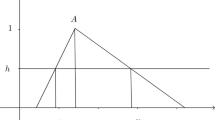Abstract
Fuzzy clusterwise regression has been a useful method for investigating cluster-level heterogeneity of observations based on linear regression. This method integrates fuzzy clustering and ordinary least-squares regression, thereby enabling to estimate regression coefficients for each cluster and fuzzy cluster memberships of observations simultaneously. In practice, however, fuzzy clusterwise regression may suffer from multicollinearity as it builds on ordinary least-squares regression. To deal with this problem in fuzzy clusterwise regression, a new method, called regularized fuzzy clusterwise ridge regression, is proposed that combines ridge regression with regularized fuzzy clustering in a unified framework. In the proposed method, ridge regression is adopted to estimate clusterwise regression coefficients while handling potential multicollinearity among predictor variables. In addition, regularized fuzzy clustering based on maximizing entropy is utilized to systematically determine an optimal degree of fuzziness in memberships. A simulation study is conducted to evaluate parameter recovery of the proposed method as compared to the extant non-regularized counterpart. The usefulness of the proposed method is illustrated by an application concerning the relationship among the characteristics of used cars.
Similar content being viewed by others
References
Aurifeille J-M, Quester PG (2003) Predicting business ethical tolerance in international markets: a concomitant clusterwise regression analysis. Int Bus Rev 12: 253–272
Belsley DA, Kuh E, Welsch RE (1980) Regression diagnostics: identifying influential data and sources of collinearity. Wiley, New York
Bezdek JC (1981) Pattern recognition with fuzzy objective function algorithms. Plenum Press, New York
Brusco MJ, Cradit JD, Steinley D, Fox GL (2008) Cautionary remarks on the use of clusterwise regression. Multivar Behav Res 43: 29–49
DeSarbo WS, Cron WL (1988) A maximum likelihood methodology for clusterwise linear regression. J Classif 5: 249–282
DeSarbo WS, Oliver RL, Rangaswamy A (1989) A simulated annealing methodology for clusterwise linear regression. Psychometrika 54: 707–736
DeVeaux RD (1989) Mixtures of linear regressions. Comput Stat Data Anal 8: 227–245
D’Urso P (2003) Linear regression analysis for fuzzy/crisp input and fuzzy/crisp output data. Comput Stat Data Anal 42: 47–72
D’Urso P, Santoro A (2006) Fuzzy clusterwise linear regression analysis with symmetrical fuzzy output variable. Comput Stat Data Anal 51: 287–313
Efron B (1982) The jackknife, the bootstrap, and other resampling plans. Society of Industrial and Applied Mathematics CBMS-NSF Monographs 38
Falk TH, Shatkay H, Chan W-Y (2006) Breast cancer prognosis via Gaussian mixture regression. Canadian conference on electrical and computer engineering, Queen’s University, Canada, pp 987–990
Gordon AD (1999) Classification. Chapman and Hall/CRC, Boca Raton
Hathaway RJ, Bezdek JC (1993) Switching regression models and fuzzy clustering. IEEE Trans Fuzzy Syst 1: 195–204
Heiser WJ, Groenen PJF (1997) Cluster differences scaling with a within-cluster loss component and a fuzzy successive approximation strategy to avoid local minima. Psychometrika 62: 63–83
Hoerl AE, Kennard RW (1970) Ridge regression: biased estimation for nonorthogonal problems. Technometrics 12: 55–67
Hoerl AE, Kennard RW (1970) Ridge regression: applications to nonorthogonal problems. Technometrics 12: 69–82
Hosmer DW (1974) Maximum likelihood estimates of the parameters of a mixture of two regression lines. Commun Stat 3: 995–1006
Hruschka H (1986) Market definition and segmentation using fuzzy clustering methods. Int J Res Mark 3: 117–134
Kuiper S (2008) Introduction to multiple regression: how much is your car worth? J Stat Educ 16. Available via http://www.amstat.org/publications/jse/v16n3/datasets.kuiper.html. Accessed 25 May 2009
Kutner MH, Nachtsheim C, Neter J (2004) Applied linear regression models. McGraw-Hill/Irwin, Boston
Laviolette M, Seaman JW (1992) Evaluating fuzzy representations of uncertainty. Math Sci 17: 26–41
Laviolette M, Seaman JW (1994) Unity and diversity of fuzziness—from a probability viewpoint. IEEE Trans Fuzzy Syst 2: 38–42
Laviolette M, Seaman JW, Barrett JD, Woodall WH (1995) A probabilistic and statistical view of fuzzy methods. Technometrics 37: 249–261
Li R-P, Mukaidono M (1995) A maximum entropy approach to fuzzy clustering. Proceedings of the 4th IEEE international conference on fuzzy systems, Yokohama, Japan, pp 2227–2232
McBratney AB, Moore AW (1985) Application of fuzzy sets to climatic classification. Agric For Meteorol 35: 165–185
Miyamoto S (1998) An overview and new methods in fuzzy clustering. In: Jain LC, Jain RK (eds) Second international conference on knowledge-based intelligent electronic systems, Adelaide, Australia, pp 21–23
Miyamoto S, Mukaidono M (1997) Fuzzy c-means as a regularization and maximum entropy approach. 7th international fuzzy systems association world congress, Prague, Czech Republic, pp 86–92
Miyamoto S, Ichihashi H, Honda K (2008) Algorithms for fuzzy clustering: methods in c-means clustering with applications. Springer, Berlin
Quandt RE (1958) The estimation of the parameters of a linear regression system obeying two separate regimes. J Am Stat Assoc 53: 873–880
Quandt RE (1972) A new approach to estimating switching regressions. J Am Stat Assoc 67: 306–310
Quandt RE, Ramsey JB (1978) Estimating mixtures of normal distributions and switching regressions. J Am Stat Assoc 73: 730–738
Späth H (1979) Algorithm 39: clusterwise linear regression. Computing 22: 367–373
Späth H (1981) Correction to algorithm 39: clusterwise linear regression. Computing 26: 275
Späth H (1982) Algorithm 48: a fast algorithm for clusterwise linear regression. Computing 29: 175–181
Späth H (1985) Cluster dissection and analysis. Wiley, New York
Takane Y, Hwang H (2007) Regularized linear and kernel redundancy analysis. Comput Stat Data Anal 52: 394–405
Tran D, Wagner M (2000) Fuzzy entropy clustering. The 9th IEEE international conference on fuzzy systems, San Antonio, pp 152–157
Wedel M, DeSarbo WS (1995) A mixture likelihood approach for generalized linear models. J Classif 12: 21–55
Wedel M, Kistemaker C (1989) Consumer benefit segmentation using clusterwise linear regression. Int J Res Mark 6: 45–49
Wedel M, Steenkamp J-BEM (1989) A fuzzy clusterwise regression approach to benefit segmentation. Int J Res Mark 6: 241–258
Wedel M, Steenkamp J-BEM (1991) A clusterwise regression method for simultaneous fuzzy market structuring and benefit segmentation. J Mark Res 28: 385–396
Yang M-S, Ko C-H (1997) On cluster-wise fuzzy regression analysis. IEEE Trans Syst Man Cybern B 27: 1–13
Author information
Authors and Affiliations
Corresponding author
Rights and permissions
About this article
Cite this article
Suk, H.W., Hwang, H. Regularized fuzzy clusterwise ridge regression. Adv Data Anal Classif 4, 35–51 (2010). https://doi.org/10.1007/s11634-009-0056-5
Received:
Revised:
Accepted:
Published:
Issue Date:
DOI: https://doi.org/10.1007/s11634-009-0056-5




